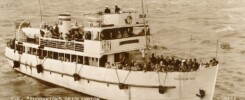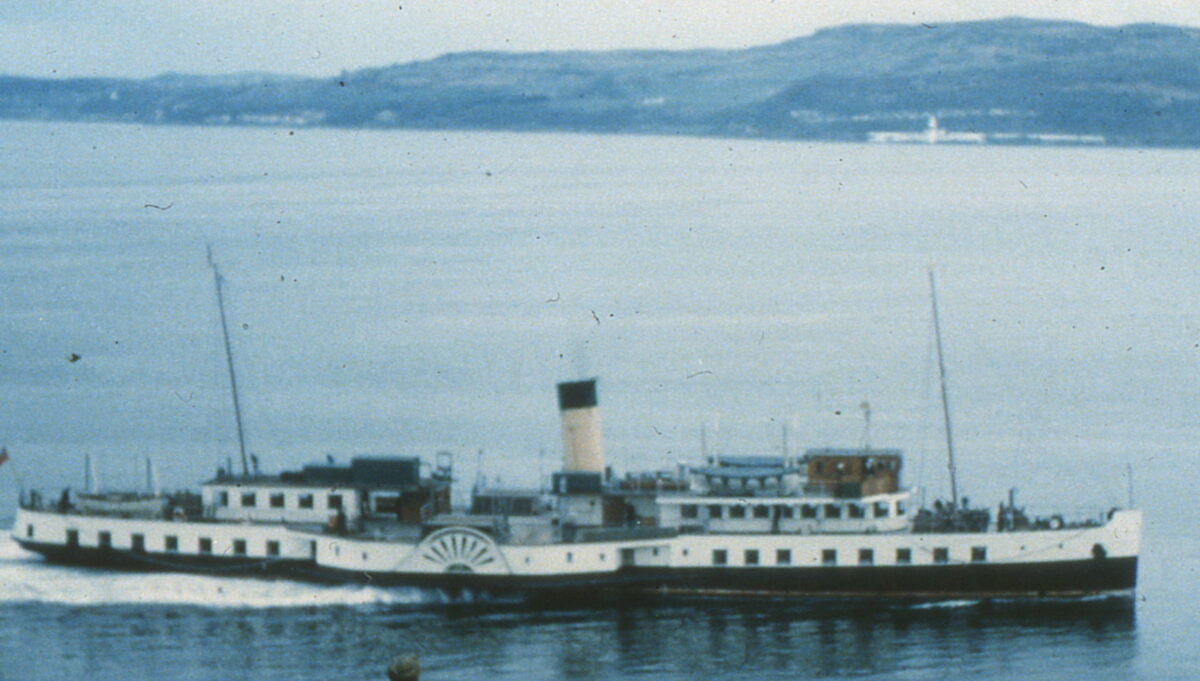
Between 1954 and 1966 Talisman spent her summers primarily running the ferry connections between Millport, Largs, Wemyss Bay and Rothesay. Yes she occasionally filled in for other steamers elsewhere sometimes running longer excursions covering breakdowns, tendering duties and so on but this was her main sphere of operation for the last thirteen summers of her operational career.
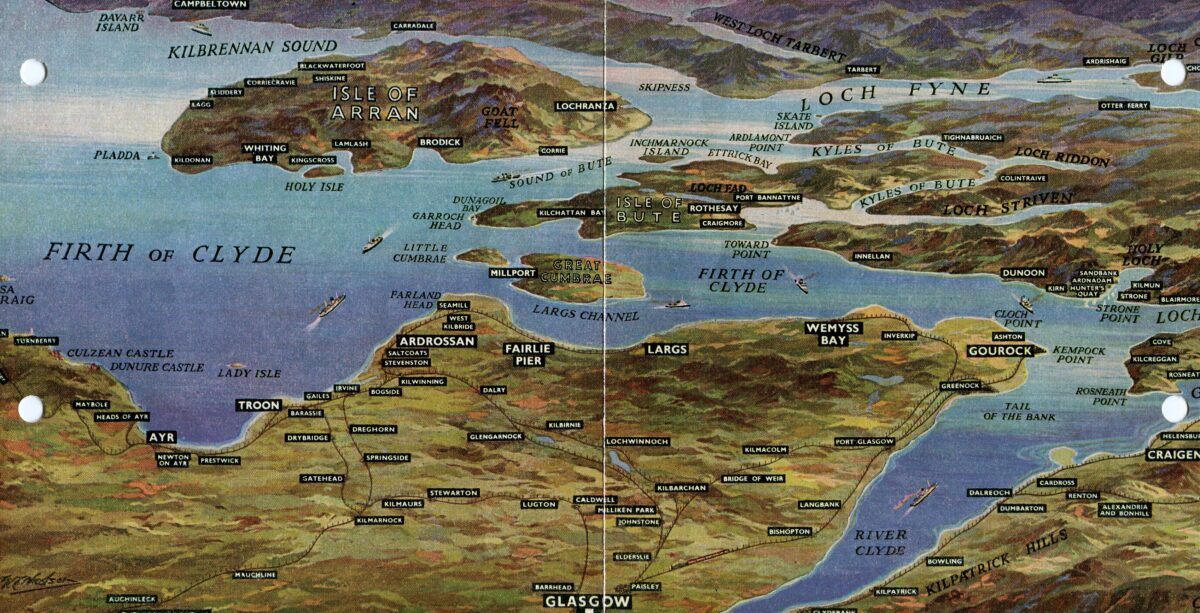
Talisman’s daily roster Mondays to Fridays during these summers included departure from Wemyss Bay at 9am for Largs 9.30am for Millport 10.15am then back to Largs 11am and Wemyss Bay. She then set off at 11.50am once again for Largs 12.20pm and on to Millport.
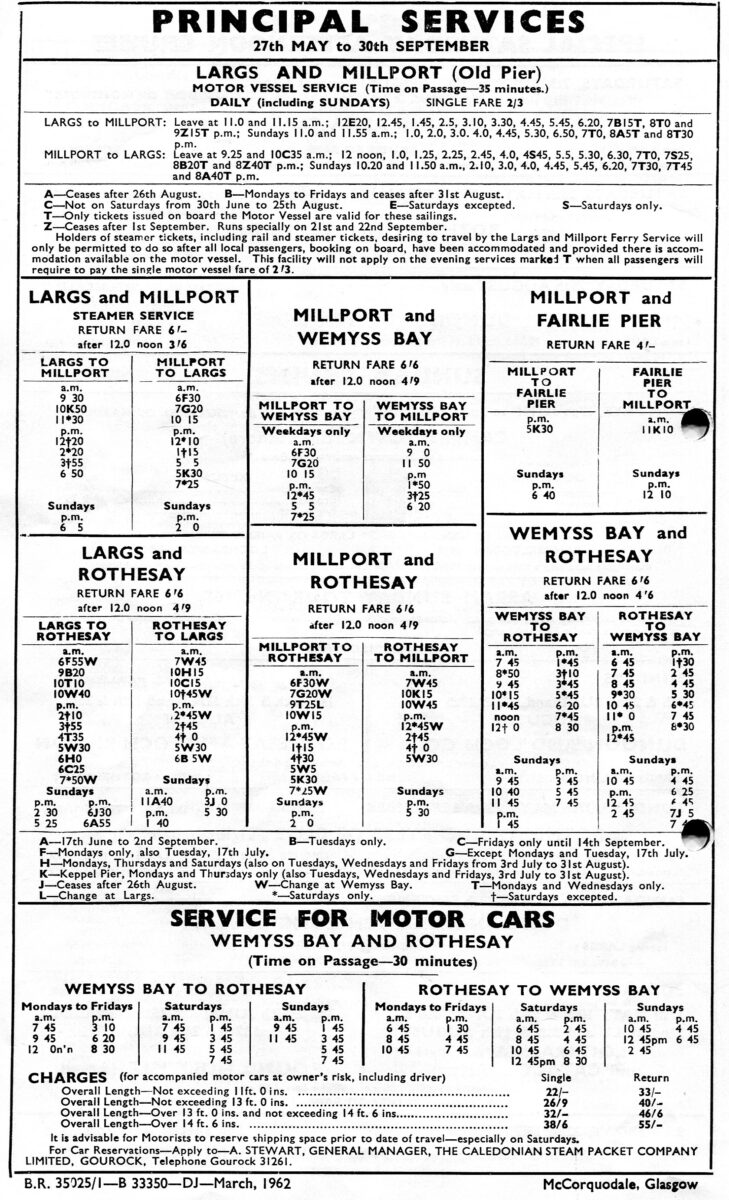
After that there was an afternoon cruise billed as the “Cumbrae Circle” away from Millport at 1.15pm and Largs 2.10am sailing south of Cumbrae through the Hunterston Channel and across the Clyde for arrival at Rothesay at 2.45pm for just over one hour ashore. Departure was at 4pm returning north of Cumbrae through the Main Firth of Clyde Channel to arrive back at Millport at 5.5pm and Largs 5.30pm. Then she proceeded onwards once again to Wemyss Bay for 6pm.
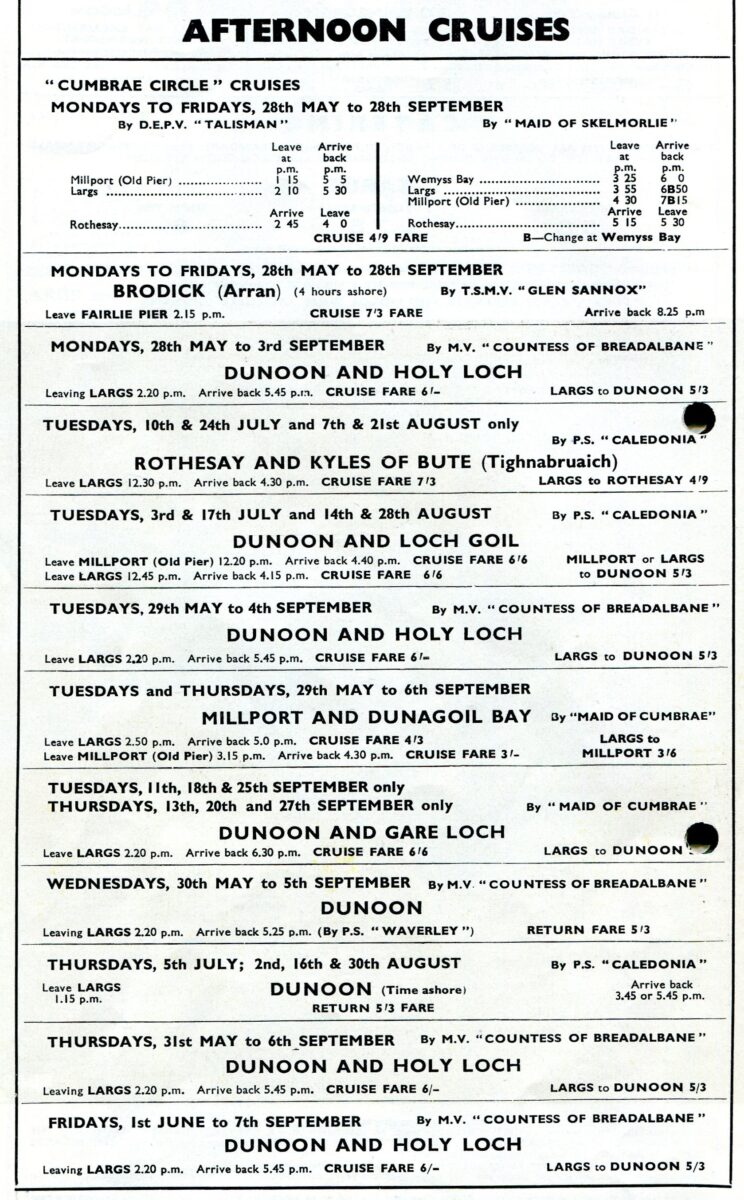
Saturdays were the real people mover days for the Clyde fleets with the world and his several wives regularly wishing to go afloat and take advantage of the main ferry crossings. This was a busy day for Talisman too with extra ferry runs taking the place of the “Cumbrae Circle” Afternoon Cruise.
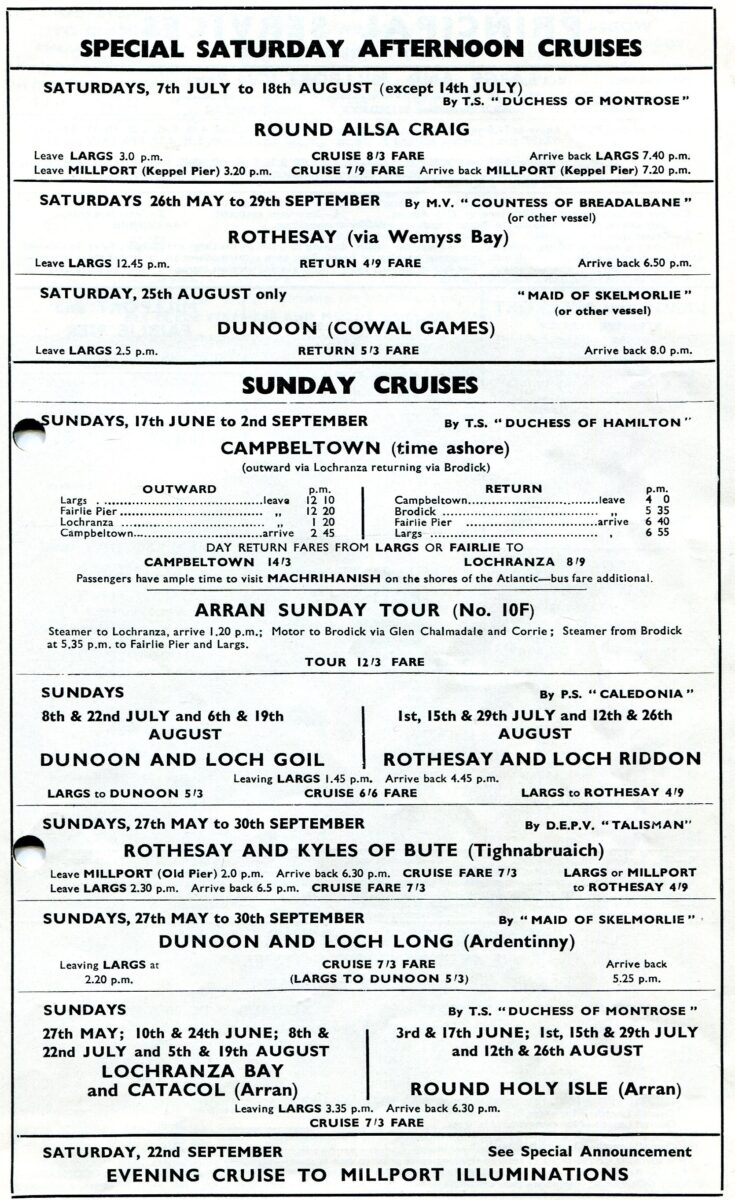
With less ferry traffic offering on Sundays Talisman ran an afternoon cruise away from Millport at 2pm and Largs 2.30pm across the Clyde to Rothesay and then on to cruise through the Kyles of Bute to Tignabruaich returning to Largs at 6.5pm and Millport at 6.30pm.
So that was Talisman’s basic roster from late May to late September each summer between 1954 and 1966.
Looking back from the perspective of today where ferries generally operate point to point and onward journeys to elsewhere are for the customer to organise for themselves by other means, one may wonder why Talisman’s service between Millport on the Isle of Cumbrae and the mainland at Largs also connected with Wemyss Bay which is only seven or so miles along the same stretch of coast. The answer to that I think is the railway. At Wemyss Bay the steamer pier was, and is, right there at the railway station. There is, and was, an undercover connection between the train and the boats which makes, made, transfer very much easier, both for passengers and also for parcels and other goods, than at Largs where the railway station is a walk of about a quarter of a mile away from the jetty. And as well as the passengers Talisman also carried a lot of parcels and other goods for onward transfer to and from the railway often wheeled aboard at both ends on barrows. Sometimes there was livestock as well on their way to or from the market.
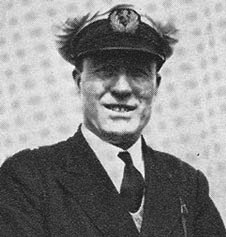
Inevitably different captains have in the past taken different views on paddle steamer handling. Maybe some were a little bit more, shall we say, adventurous than others. Alan Brown in his excellent book “Talisman, the Solitary Crusader” records that after Talisman’s then master Captain Colin MacKay transferred to our Waverley in 1956 there were some complaints from some passengers levelled at his replacements in that in blustery conditions they sometimes had a tendency to terminate at Keppel Pier on Cumbrae rather than going on round to Millport itself. But in fairness Millport was ever a tricky berth to use particularly in wind with the approach and exit surrounded on both sides by unfriendly rocks with little leeway to get out of difficulty if a manoeuvre did not work out as planned.
One change over all the years since I started to work afloat in the 1960s has been that the discretion about the decision making process for such things has increasingly been taken away from captains who must now comply with what is set out for them to do in their Safety Management Systems. And if the SMS decrees that a particular ship shall not call at such and such a pier, or not sail at all, if the wind is over a defined force and fetch then that’s it. The captain has no option but to comply.
Of course different companies may have different criteria in their different Safety Management Systems as to what their own ships may or may not be allowed to do. Although all SMS must in the end be approved by the MCA they are written by the owning companies and it is their job to persuade the MCA that the SMS they propose will work taking account of their different personnel and different handling characteristics and other qualities of their different ships. No two SMS will necessarily be alike.
For example in recent weeks I have noticed that there have been times when all the Clyde ferries run both by CalMac and Western Ferries have been pulled from service due to the weather and in compliance with their own SMSs. But there have been other occasions when Western Ferries have been operating normally between Hunters Quay and McInroy’s Point whilst in compliance with their SMS whilst the CalMac ships were not in service whilst in compliance with their SMS with the interesting result that sometimes when the CalMac Gourock/Dunoon ferry service is pulled due to the weather, their passengers are transferred by bus to make the crossing with Western Ferries instead.
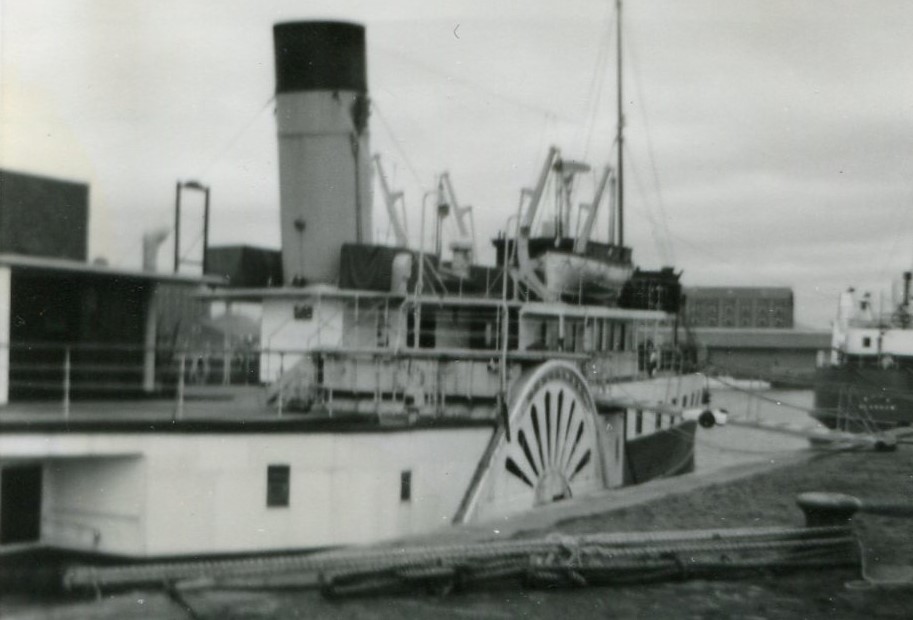
But back to Talisman. Out of season she was stand by vessel at Gourock throughout the whole of the winters from October 1954 to March 1957 sailing off after that for her annual refit with the intention of her being ready to start again each Easter on the Millport ferry run.
In the winters from October 1957 onwards to her end in 1966 she was taken out of service from October to December for her annual refit and then took up her duties as stand by ship at Gourock for the second part of each winter. She was therefore a really useful ship for the Caledonian Steam Packet Company not least with her ability to flash up her diesel engines and be ready to jump into service pretty much straight away if called upon to do so without the lead time needed for a steamer to raise steam from simmering to operational pressure.
Talisman’s last sailing from Millport was on Sunday 30th October 1966 from where she departed with no ceremony at 4pm. Her final passenger sailing was on Thursday 17th November 1966 when she covered the Holy Loch service of the Maid of Skelmorlie which was busy on tendering duties to the Canadian Pacific liner Empress of Scotland. After that she was laid up at Greenock and put up for sale through the agency of A M C McGinnity & Partners of Weymouth. And yes that’s the same A M C Mcginnity who was a founder member of the PSPS, had his finger in pretty much all paddle steamer pies in the 1960s and who bought and operated PS Consul in 1963 and 1964.
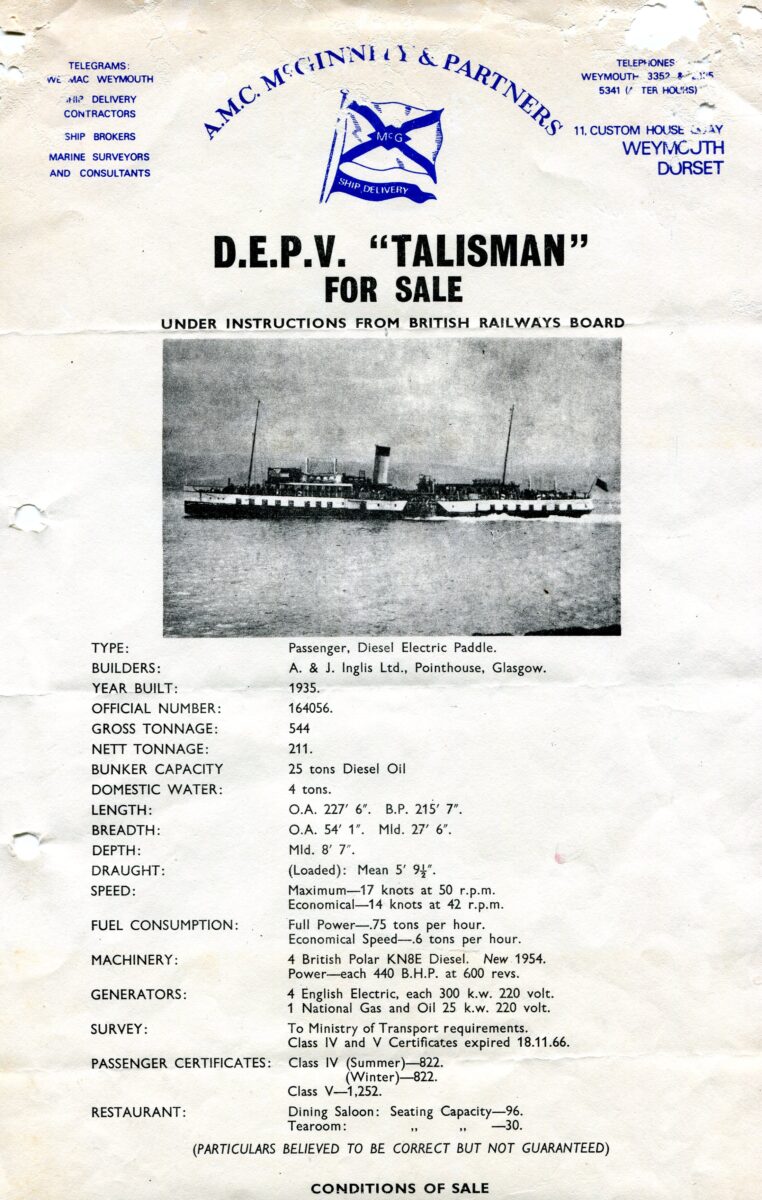
I think that the details on these For Sale flyers are fascinating for what they reveal about the ships. For example Talisman’s fuel consumption at Full Power was said to be 0.75 tons per hour but at Economical Speed only 0.6tons per hour. Slowing a ship down saves money on fuel. Her dining saloon had a capacity for only 96 and the tearoom just 30 passengers compared with her passenger capacity of 822. That leaves 696 hungry passengers if all want to dine aboard at the same time. By this stage in her career she had lost her Class III seagoing Passenger Certificate and had been running the services connecting Millport, Largs, Wemyss Bay, Rothesay and Tignabruaich on her Class IV and V Passenger Certificates for Categorised Waters only. There’s a lot you can do on the Clyde without the full weight of a sea-going passenger certificate. And having been built in 1935 Talisman was by 1966 thirty one years old which is beyond the design life of steel hulled ships. If you want to keep a ship in service longer than that then you have to be prepared to spend significant sums of money on renewing the steelwork and other fabric of the vessel as necessary.
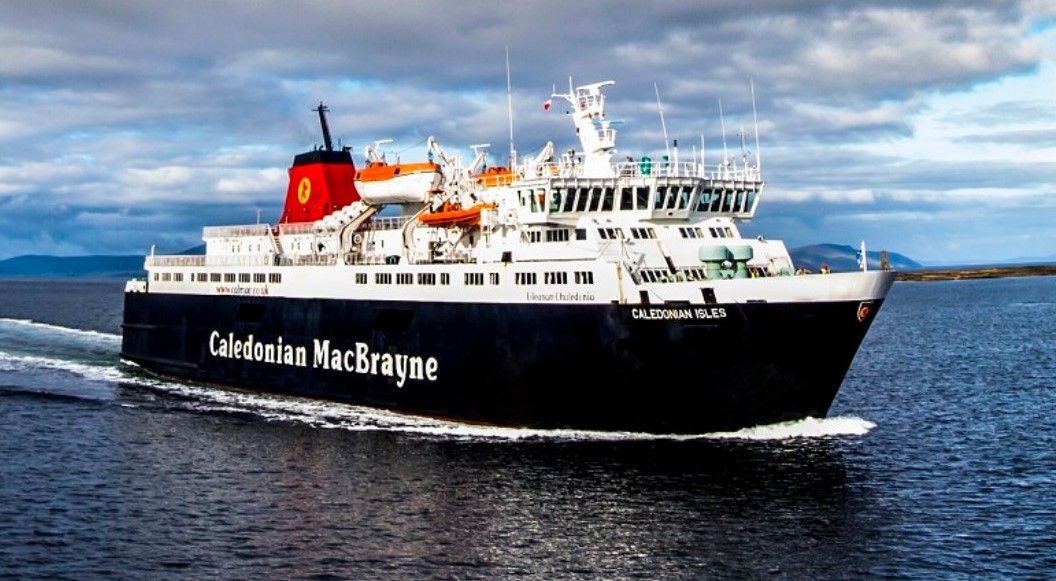
And as a case in point which is hot news right now CalMac’s thirty one year old Caledonian Isles did not return to service on the Ardrossan-Brodick run as planned on 25th January. As part of the surveys required for renewal of her Class Certification an increased scope of steel repairs and renewals beyond those originally planned were identified which requires an extension of the planned Annual Overhaul schedule. CalMac are saying on their website that they are engaged with all relevant stakeholders to evaluate all options for the required repairs and will provide an update once this plan has been finalised.
Kingswear Castle returned to service in 2023 after the first part of a major rebuild which is designed to set her up for the next 25 years running on the River Dart. The Paddle Steamer Kingswear Castle Trust is now fund raising for the second phase of the rebuild. You can read more about the rebuilds and how you can help if you can here.
John Megoran

